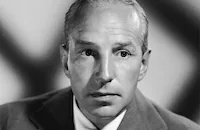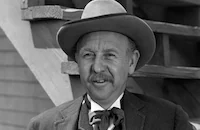Somewhere in the Night
Cast & Crew
Joseph L. Mankiewicz
John Hodiak
Nancy Guild
Lloyd Nolan
Richard Conte
Josephine Hutchinson
Film Details
Technical Specs

Synopsis
A U.S. Marine recovering from a combat injury in a Navy hospital in Hawaii suffers from undiagnosed amnesia, and while others call him George Taylor, he has no memory of that man. Upon recovery from his wounds, George is transferred to the hospital at Camp Pendleton, California, and is eventually discharged, even though he still has no memory. He returns to his old civilian address at the Martin Hotel in Los Angeles, but no one recognizes him there. At Union Station, he exchanges a bag check he found in his sea bag for a briefcase, which contains a gun and a three-year-old letter to a man named George stating that $5,000 has been deposited for him in a bank account by Larry Cravat. George goes to the bank, but the officials ask him too many questions and he leaves abruptly. The owner of the Elite Baths, from where Cravat wrote the letter, tells George he does not know Cravat but suggests that he check at a nearby nightclub, The Cellar. There, a bartender tips off two thugs that someone is asking about Cravat. While trying to lose the thugs, George enters the club's rear premises and ends up in singer Christy Smith's dressing room. George finds an old postcard to Christy from "Mary," stating that she will soon be Mrs. Larry Cravat. Back at his hotel, George is approached by a woman called Phyllis, who tries to pick him up. The bartender then phones him with instructions to return to the club for new information. When George gets there, he finds the club closed, but encounters a Mr. Anzelmo, who has him roughed up and warns him to stop looking for Cravat, then dumps him at Christy's place. Christy tells George that Mary, her best friend, was stood up by Cravat on her wedding day and was later reported killed while crossing a street. After George tells Christy his story, The Cellar's owner, Mel Phillips, stops by with the news that the bartender has been found dead in a vacant lot. Phillips suggests that a police friend, Lt. Donald Kendall, might be able to help George and arranges a meeting with him. Kendall reveals that Cravat was a private detective and, at the time of his disappearance, was in possession of $2,000,000 that had been smuggled out of Nazi Germany. George then receives an anonymous note, which leads him to a fortune-teller near Terminal Dock, where he encounters Anzelmo and Phyllis. Anzelmo informs George that Cravat is wanted by the police for a murder that took place on the dock three years previously. Anzelmo offers to provide evidence clearing Cravat of the murder in exchange for a considerable amount of money and suggests that George may have been involved in the murder and could be the "fall guy." Later, Christy tells Phillips that George has gone to see Michael Conroy, a witness to the dock murder, and adds that she is "nuts" about George. Conroy's daughter Elizabeth tells George that her father had an accident three years ago and has been confined to the Lambeth Sanitarium ever since. On leaving Elizabeth, George is almost run down by a truck, but eventually gains access to the sanitarium. George arrives to find Conroy has been stabbed, but before he dies, Conroy tells him that one of the killers dropped a suitcase which he, Conroy, hid under the dock. Christy and George recover the suitcase, which contains the $2,000,000 and an item of clothing with a tag indicating that it was made for Larry Cravat by "W. George-Tailor." George now thinks that perhaps he is Cravat and hid out with the Marines under the name George Taylor. Christy doubts George's theory, but when he asks her to read a letter he found in his wallet while he was hospitalized, she recognizes the handwriting as Mary's. They are then surprised by someone who shoots at them, but escape to a nearby mission, where they ask the director to deliver the suitcase to Lt. Kendall while they go to see Anzelmo. After George tries to convince Anzelmo and Phyllis that he is Cravat and that his face was altered as a result of the war wound, Phillips shows up and is surprised to learn that George is Cravat. When Anzelmo tries to frame Phyllis for the murder on the dock, she pulls a gun on them, but Phillips gets control of the weapon and he, Christy and George leave for The Cellar. Phillips then reveals that he is the killer and had arranged to pick up the $2,000,000 from a Mr. Steel, but Cravat heard about it, convinced Steel that he was Phillips and got the money. When Phillips arrived, Steel was alone and Phillips, thinking Steel had double-crossed him, killed him. George tells Phillips that they have recovered the money and offers him the suitcase in exchange for Christy's freedom. They return to the mission, where Lt. Kendall and his men have set up a stakeout, and Kendall shoots Phillips. At the police station, Kendall congratulates George for helping to solve the murder. His past restored, George and Christy then leave together.

Director

Joseph L. Mankiewicz
Cast

John Hodiak
Nancy Guild

Lloyd Nolan

Richard Conte

Josephine Hutchinson
Fritz Kortner
Margo Woode

Sheldon Leonard
Lou Nova
Houseley Stevenson
John Russell
Philip Van Zandt
John Kellogg
Polly Rose
Paula Reid

Richard Benedict
Charles Marsh
Milt Kibbee
Harry Tyler

Jeff Corey
Sam Flint
Forbes Murray

Henry Morgan

Whitner Bissell
Al Sparlis

Charles Arnt
Mary Currier
Jack Davis
Clancy Cooper
Louis Mason
Henri De Soto
Elaine Langan
Edward Kelly Jr.
Cy Schindel
Maynard Holmes
Crew
Harold Adamson
James Basevi
Marvin Borowsky
James Breen
Norbert Brodine
Sonny Burke
David Buttolph
James B. Clark
Howard Dimsdale
Duke Ellington
A. F. "buddy" Erickson
Curtis Fetters
Eugene Grossman
Edwin Hammeras
Commander H. R. Hartwell
F. E. Johnston
Ernest Lansing
Anderson Lawler
Harry M. Leonard
Thomas Little
Joseph L. Mankiewicz
William May
Jimmy Mchugh
Arthur Morton
Paul Neal
Kay Nelson
Emil Newman
Ben Nye
Florence O'neill
Maurice Ransford
Fred Sersen
Charles L. Smith
Edward Snyder
Murray Spivack
Lee Strasberg
Lee Strasberg
Frank Sullivan
J. O. Taylor
Urban Thielmann
Urban Thielmann
Darryl F. Zanuck

Film Details
Technical Specs

Articles
Somewhere in the Night on DVD
Probably the least convincing aspect of this intriguing yet convoluted - and at a certain point incomprehensible - plot is Taylor's decision not to tell anyone that he has amnesia. You basically have to just accept this and move on. The complexity of the rest of the movie works because the movie has already done such a good job of making us share Taylor's confusion. To make us feel further confused by the story itself, after all, does mirror Taylor's state of mind. That said, director Joseph L. Mankiewicz never really re-captures the initial cinematic thrill of Taylor's daze. When he's lying in the hospital bed, Mankiewicz uses close-ups of his eyes, striking POV shots and vivid voiceover to immerse us completely inside Taylor. This type of powerful subjectivity gets lost along the way.
It's not too surprising, really, for Mankiewicz was never especially known as a visual stylist. His movies generally work due to excellent performances and scripts, especially dialogue. After a writing career that began in 1929, Somewhere in the Nigh was his first full feature as a director. (He had previously completed directing Dragonwyck, 1946, when original director Ernst Lubitsch fell ill during production.)
The resources of Twentieth Century Fox helped the novice director considerably. The great supporting cast, for instance, includes Richard Conte, Lloyd Nolan, Henry Morgan, Sheldon Leonard, Fritz Kortner, Jeff Corey, Whit Bissell and Josephine Hutchinson, who steals the show in her one poignant scene. Co-star Nancy Guild was a newcomer, billed by the Fox publicity machine as "Nancy Guild rhymes with wild." (She never became a major actress, however.) Also helping considerably was twice Oscar®-nominated cinematographer Norbert Brodine, whose crisp black-and-white images capture the quintessential noir look. Mankiewicz's dexterity with actors and Brodine's talent with lighting and angles create some wonderful moments of dread. Watch, for example, the scene where Hodiak enters a nightclub early in the movie and asks the bartender about a man he's looking for. The bustling, safe space suddenly becomes dark, menacing, and sinister - the kind of tonal shift which is pure film noir.
Somewhere in the Night captures a sense of post-WWII anxiety. Upon returning from the war, Taylor clearly feels alienated and displaced, with little idea of his direction in society. As in many other noirs, this is a reflection of a real social condition - it's just stylized with things like amnesia, with murder and mayhem thrown in. The dialogue also is full of allusions to these issues, with lines like "Do you know what it's like to be alone in the world?" and "I don't have to be afraid of the world anymore" running through the entire picture.
Typical of the Fox Film Noir series, Somewhere in the Night looks and sounds wonderful. The commentary track by noir historian Eddie Muller is overall worthwhile, and Muller has some good insights into the noir style, saying, for example, "In film noir, the good women work for a living and the bad women want something for nothing." Hard to argue with that observation.
For more information about Somewhere in the Night, visit Fox Home Entertainment. To order Somewhere in the Night, go to TCM Shopping.
by Jeremy Arnold

Somewhere in the Night on DVD
Quotes
Trivia
Notes
According to documents in the Twentieth Century-Fox Records of the Legal Department and the Twentieth Century-Fox Produced Scripts Collection at the UCLA Arts-Special Collections Library, the studio purchased Marvin Borowsky's original, unpublished story "The Lonely Journey" and his accompanying screenplay in December 1944 for $11,000. Ben Simkhovitch, Howard Dimsdale and Lee Strasberg worked on subsequent drafts of the script and there is a record of a July 1945 story conference held at director George Cukor's home in which producer Lawler, Mankiewicz, Strasberg and guest, W. Somerset Maugham, participated. Mankiewicz wrote the final version of the screenplay, which was greeted with some bewilderment by several contemporary critics. Bosley Crowther's review in the New York Times complained about the complicated plot: "The further this un-remembering gentleman pursues his mysterious past and confronts odd and brutal characters, the more he-and you-become confused. Apparently he and his associates fit the pieces together in the end, but this writer is still completely baffled. Who was who, and who got shot?" James Breen, a Marine veteran and son of Production Code Administration director Joseph I. Breen, was technical advisor on the final screenplay.
Somewhere in the Night was Nancy Guild's first film. According to a studio press release in the AMPAS Library, she was discovered after a studio executive saw a photograph of her in a Life article on the University of Arizona, which she was attending. A week after her screen test she was cast in Somewhere in the Night. Studio records list Polly Rose in the role of a nurse. Frank Meredith is also listed in studio documents as appearing in this film, but his participation in the released film has not been confirmed. A radio version of the film, starring John Hodiak and Lynn Bari, was broadcast on Lux Radio Theatre on March 3, 1947.














